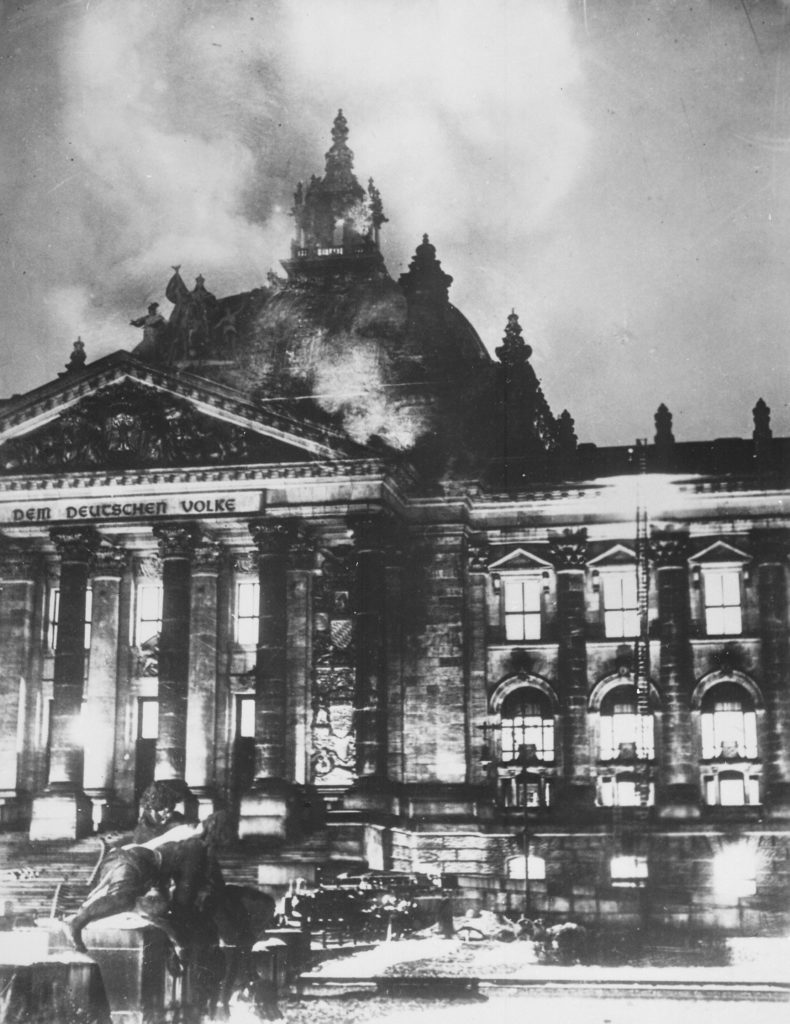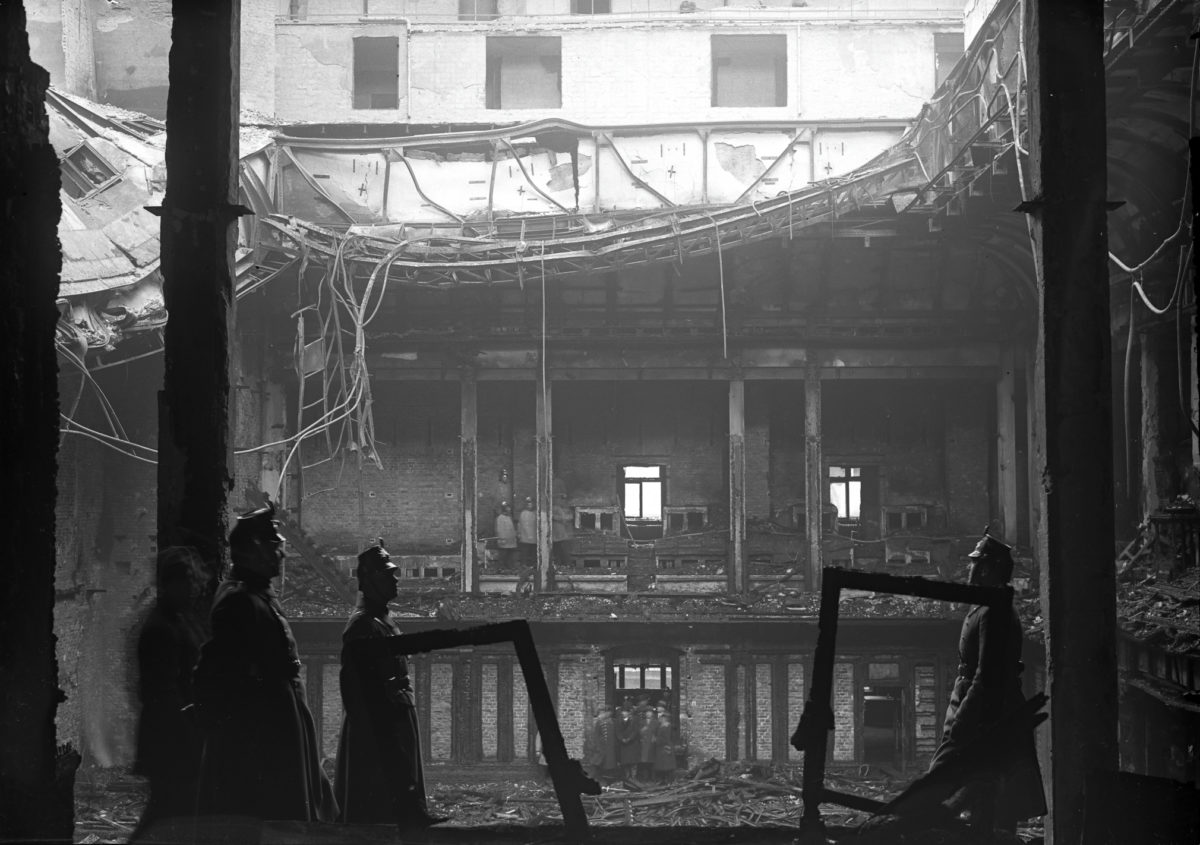On Feb. 27, 1933, Germany’s parliament building in Berlin, then known as the Reichstag, was set ablaze. Fire engulfed most of the building, shooting out from its dome. The damage was catastrophic. The very next day on Feb. 28, Adolf Hitler, who had been sworn in as Chancellor only weeks earlier, was quick to put pen to paper to sign what has become known as the Reichstag Fire Decree.
“Articles 114, 115, 117, 118, 123, 124, and 153 of the Constitution of the German Reich are suspended until further notice,” read the degree with chilling brevity. “Thus, restrictions on personal liberty, on the right of free expression of opinion, including freedom of the press, on the right of assembly and the right of association, and violations of the privacy of postal, telegraphic, and telephonic communications, and warrants for house searches, orders for confiscations as well as restrictions on property are permissible” beyond ordinary legal limits, it stated, adding: “This decree enters into force on the day of its promulgation.”
Unsuspecting inhabitants of Germany found they had woken up to a different reality on Feb 28. Their civil rights literally disappeared overnight.
Who Started the Fire?
The fire was more than just convenient for the Nazis—aside from their leader, Hitler, being granted unlimited powers, they also had an opportunity to sweep away political opposition. In the style of ancient Rome’s Emperor Nero, they blamed the fire on a group of people they wanted to get rid of—in this case, communists. The same day Hitler signed the decree, police and paramilitary forces swept through streets and neighborhoods with precision, arresting communists and political opponents in the thousands. There was nothing to stop Hitler from formally receiving more power in elections coming up within weeks. This was a coup d’etat.
The fire itself has proved a stumbling block for historians for decades. This is largely due to the unknown role of the man who ended up being executed for the arson—a 24-year-old Dutch communist named Marinus van der Lubbe. Was he actually involved in starting the fire or was he simply a fall guy?
The University of Leipzig hopes to discover new details about the case by examining Van der Lubbe’s recently exhumed remains.
An Unlikely Culprit
Marinus Van der Lubbe was probably one of the most unlikely suspected arsonists ever to stand trial. The unemployed construction worker was partially blind due to an industrial accident. In terms of evidence, he was said to have been found at the scene of the crime armed with some meager coal lighters. After his arrest, he allegedly repeated the phrase that he wanted to inspire a communist revolution “against capitalist rule and fascist seizure of power.” He also reportedly insisted that he had acted alone.
However, Van der Lubbe appeared listless during his trial—drooping, in fact, and with a constantly runny nose he was unable to wipe. Strangely, although he could speak German, Van der Lubbe needed a translator’s assistance during the trial.
The Nazis declared that Van der Lubbe was the mastermind behind the fire. They wanted the public and the international press to believe that, with his measly coal lighters, the young Dutchman had ignited the whole Reichstag building in something like a spontaneous combustion.
After a show trial, he was beheaded by guillotine on Jan. 10, 1934 and his remains were interred in an unmarked plot in Leipzig’s Südfriedhof cemetery.

The Debate
Even in the immediate aftermath of the fire, Communist sources sought to refute the accusations that they were responsible for the fire and, to do so, came up with various theories about how the Nazis might have done it. German historians in the postwar era have argued that the Nazis were not responsible and the whole thing was just a coincidence. Others have fiercely attacked both the Communists and the postwar German historians.
The hard fact remains that, from a purely technical point of view, it would be extremely difficult for a single person, especially using the type of coal lighters attributed to Van der Lubbe, to send the whole parliament building up in smoke. It is also a fact that the fire facilitated the Nazis’ aims for power—and the meticulous and far-reaching extent to which this was accomplished by political and police forces indicates more than a mere coincidence.
Historian Benjamin Carter Hett told The Guardian that “evidence is overwhelming” that Van der Lubbe could not have started the blaze alone. “There is no way he could have set fire to the plenary chamber within the 15 to 20 minutes at his disposal. He would have needed a hydrocarbon accelerant,” he said.
Experts in Germany who analyzed the 1933 investigation and attempted to reconstruct the fire also found that it would have been impossible for Van der Lubbe to do so in the manner that was alleged.
Evidence Suggesting His Innocence
Evidence from the Nuremberg Trials and recently discovered documents in Hanover archives weigh in favor of Van der Lubbe’s innocence.
Hans Bernd Gisevius, who worked for the Gestapo in 1933 and later as an Abwehr intelligence operative who conspired against Hitler during World War II, testified to the International Military Tribunal at Nuremberg in April 1946 that the Reichstag fire had been orchestrated by the Nazis.
“To speak briefly and to begin with the facts, we ascertained that Hitler in a general way had expressed a wish for a large-scale propaganda campaign. Goebbels undertook to prepare the necessary proposals and it was Goebbels who first thought of setting the Reichstag on fire. Goebbels discussed this with the leader of the Berlin SA Brigade, Karl Ernst, and he suggested in detail how it should be done,” he said.
“A certain chemical, known to every maker of fireworks, was chosen. After spraying it, it ignites after a certain time-hours or minutes. In order to get inside the Reichstag, one had to go through the corridor leading from the palace of the Reichstag President to the Reichstag itself. Ten reliable SA men were provided, and then Goering was informed of all the details of the plan, so that by chance he did not make an election speech on that particular evening…Goering—and he gave assurances that he would do so—was to put the police on wrong trails in the first confusion. From the very beginning it was intended that the Communists should be accused of this crime, and the 10 SA men who had to carry out the crime were instructed accordingly.”
Gisevius, testifying as a defense witness during the trial, added that one of the SA men named Rall later attempted to tell the truth about the fire to a court in Leipzig but “was murdered in a vile manner with the knowledge of the Defendant Goering, by order of Gestapo chief Diels.” He also testified that other SA troopers who started the fire were silenced “under the pretext of the Roehm revolt.”
Documents recently discovered in Hanover, which contain postwar statements from former SA member Hans-Martin Lennings, corroborate Gisevius’ testimony. Lennings claimed he helped to frame Van der Lubbe for the fire. He stated that Karl Ernst—previously mentioned by Gisevius—had ordered him to pick up the Dutchman from an SA hospital and drive him to the Reichstag. Lennings described the young man as being in a dazed condition.
Experts in Germany who conducted a reconstruction of the fire found that a liquid chemical agent of the type described by Gisevius at Nuremberg would indeed have started a blazing fire like a “chemical time bomb” and allowed the arsonists to get away. In addition, German newspaper Die Tagezeitung points out that a tunnel from the Reichstag building connecting to various federal buildings would have enabled SA men to reach the place quickly and undetected.
Reinvestigating Van Der Lubbe
Some historians maintain the opinion that Van der Lubbe was in some way responsible. One major sticking point for some is that Goebbels himself denied previous knowledge about the fire in his diary, whereas Goebbels described other Nazi crimes openly. It’s worth considering that, while admitting to crimes against perceived outsiders and enemies to Nazi ideology was obviously acceptable for Goebbels, admitting to burning down Germany’s own Reichstag building, a symbol of the German people, was a deed that very few Nazis would have been willing to own up to.
Can science shed light on the truth? Members of the Paul Benndorf Society in Leipzig, hoping to pinpoint where exactly Van der Lubbe was buried, oversaw the exhumation of his remains on Jan. 25, 2023. The remains recovered are a match with Van der Lubbe due to evidence of decapitation consistent with a blow from a guillotine.
Medical investigators from the University of Leipzig are testing the remains for evidence of toxins. They hope their findings will indicate whether the Nazis extracted a confession from the young man by drugging him.
“We are doing this pro bono because we find the case exciting,” Senior Physician Carsten Babian told Der Spiegel.
Van der Lubbe’s surviving relatives however are not happy about the forensic examination, expressing the view that his remains have been violated by being needlessly disturbed.
According to the University of Leipzig, the results are expected within weeks. They might not provide all the answers that historians are looking for, but they could certainly provide clarity.





